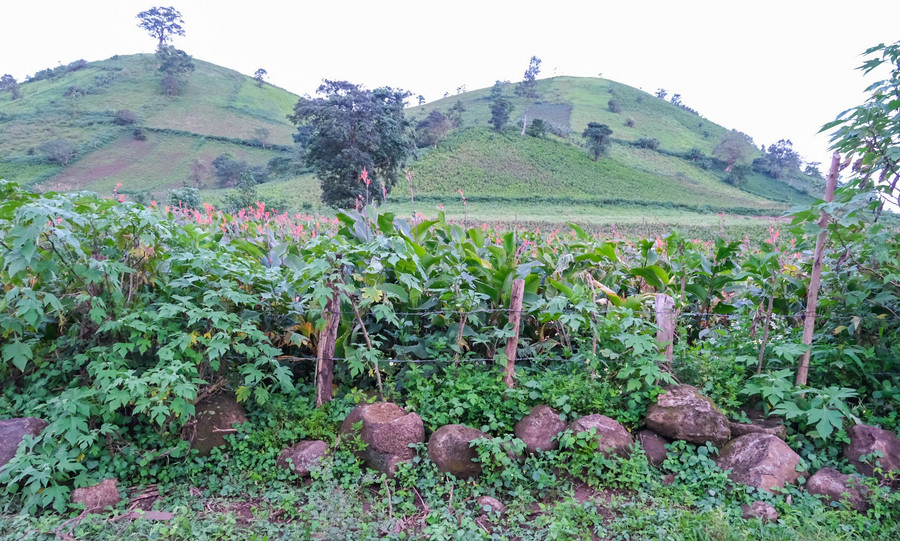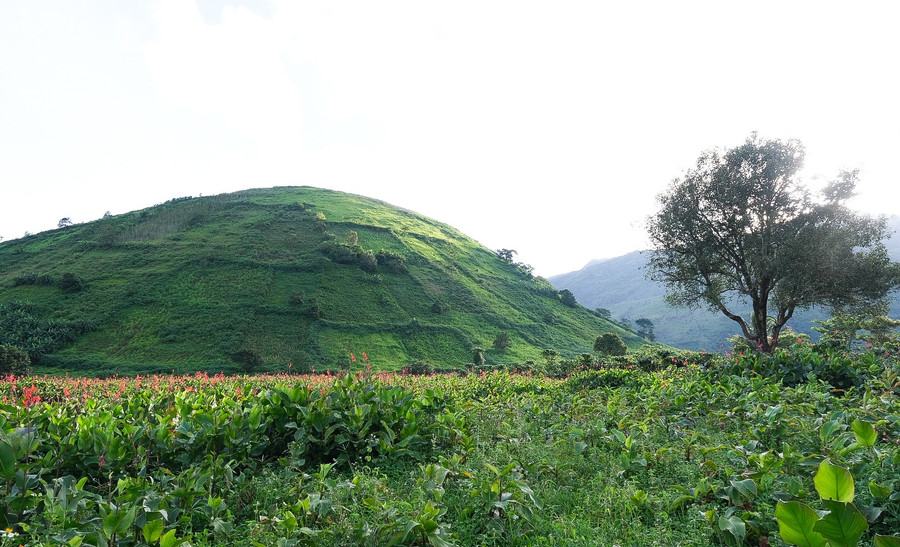Around Chu Dang Ya volcano, with each hoe stroke of the Jrai people, volcanic rocks appear, lying thickly under the fertile basalt soil. Many families gather them into piles in the corner of the garden.

Mr. Hyut in Xoa village (Bien Ho commune) said that since he was a child, following his father to reclaim land at the foot of the mountain, he became familiar with the image of ancient stones scattered everywhere. Father and son often gathered them into piles for convenient farming. Later, when building a house, he used those stones to make gate and fence posts.
The house is located on the main road, surrounded by ancient stone pillars that attract the eyes of passersby because of its rusticity and solidity, while exuding the ingenuity and creativity of the owner.
The million-year-old stones are still present in the largest religious structure of the Jrai people here. Mr. Hyut said: “The Chu Dang Ya church in the village did not have a protective fence before, and the people were poor, so no one had the means to contribute money to build it. Seeing that there were many volcanic rocks around the area, and the church was located close to the foot of the mountain, I immediately called on the people to join hands to collect stones to build it.”
In the memory of the village elder Me, the days when the Jrai people carried each block of stone back to build the structure were like a labor festival: In this land, wherever you go, you will see volcanic rocks. Old and young, men and women gathered together to go up the mountain, and in just a few days, they had carried enough stones back to build a large structure for the church.
In the vast grounds of the church, which is backed by the mountain, volcanic rocks are everywhere. Not only do they form the surrounding fence, they are also present in every gate post, flower bed, and landscape corner, creating a majestic yet natural look.
Right in front of the main gate of the church, a large volcanic bomb is placed as a highlight among the colorful flowers, as a reminder of the connection between nature and people in the red basalt land.
Village elder Me added that, since ancient times when they established Xoa village at the foot of the mountain, the Jrai ancestors had to face the great challenge of volcanic rocks. When planting trees on the mountain, they encountered rocks. When digging the foundation of a house, they encountered rocks. Even when digging a hole to plant coffee, they encountered layers of rocks piled up underneath.
However, after hundreds of years of accumulating memories, the Jrai people gradually learned how to live with the million-year-old rocks, turning obstacles into materials for life. On the rocky land, trees are still green, crops are abundant thanks to the patient hands of humans.
Perhaps deep under the fields of cassava and sweet potatoes in the village, there are still millions of ancient stones hidden. On the ground, people patiently bring each stone to a place, turning them into fences, house gates, field banks... and then together create a unique cultural landscape at the foot of the volcano. Therefore, for the Jrai people, volcanic rocks are now considered a gift from Yang Mountain. The ancient stone memories gradually become stronger with the long happy seasons.

A young man named Hyem, a member of the younger generation of Xoa village, shared: “Since this land has developed tourism thanks to the Chu Dang Ya volcano, I have learned more about this natural phenomenon. Before, when I went to work on the fields, I only found it annoying when I encountered rocks, but now, every time I encounter volcanic rocks, I feel excited and proud, because they are only found in my hometown. Right on the top of the mountain, there is a large rock placed as a symbol - that is also the pride of our Jrai community.”
At the end of 2020, Gia Lai Provincial Museum (now Pleiku Museum) organized a scientific conference on Chu Dang Ya volcano. Geologist Luong Thi Tuat said: During the survey of the volcanic system in Vietnam, scientists have only recorded about 8 types of volcanic bombs.
At Chu Dang Ya alone, 6-7 types have been discovered, such as eagle bombs, strip bombs (or ribbon bombs), cannon bombs, bread bombs... This is a diversity never seen before in any other volcano in the country.
According to Ms. Tuat, these valuable specimens are also "visual aids" to raise public awareness of geological heritage, while opening up the potential to link research and conservation with tourism development and local economy .
Source: https://baogialai.com.vn/bom-nui-lua-chu-dang-ya-gia-lai-dau-an-trieu-nam-ky-thu-cua-tu-nhien-post566291.html




![[Photo] Where the history of resistance comes alive with modern technology at "95 years of the Party Flag lighting the way"](https://vphoto.vietnam.vn/thumb/1200x675/vietnam/resource/IMAGE/2025/9/12/81c1276f52b849c8b16e2d01dd1c85e4)

































![[Photo] General Secretary To Lam chairs the Politburo's working session with the Standing Committee of the National Assembly Party Committee](https://vphoto.vietnam.vn/thumb/1200x675/vietnam/resource/IMAGE/2025/9/11/e2033912ce7a4251baba705afb4d413c)




















![[Maritime News] More than 60 containers fell off a cargo ship at Long Beach port (USA)](https://vphoto.vietnam.vn/thumb/402x226/vietnam/resource/IMAGE/2025/9/12/c091e4bb10e54291977aab80f5a41a9c)










































Comment (0)